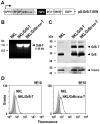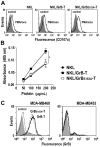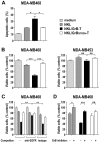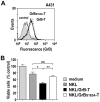EGFR-targeted granzyme B expressed in NK cells enhances natural cytotoxicity and mediates specific killing of tumor cells
- PMID: 23573299
- PMCID: PMC3616035
- DOI: 10.1371/journal.pone.0061267
EGFR-targeted granzyme B expressed in NK cells enhances natural cytotoxicity and mediates specific killing of tumor cells
Abstract
Natural killer (NK) cells are highly specialized effectors of the innate immune system that hold promise for adoptive cancer immunotherapy. Their cell killing activity is primarily mediated by the pro-apoptotic serine protease granzyme B (GrB), which enters targets cells with the help of the pore-forming protein perforin. We investigated expression of a chimeric GrB fusion protein in NK cells as a means to augment their antitumoral activity. For selective targeting to tumor cells, we fused the epidermal growth factor receptor (EGFR) peptide ligand transforming growth factor α (TGFα) to human pre-pro-GrB. Established human NKL natural killer cells transduced with a lentiviral vector expressed this GrB-TGFα (GrB-T) molecule in amounts comparable to endogenous wildtype GrB. Activation of the genetically modified NK cells by cognate target cells resulted in the release of GrB-T together with endogenous granzymes and perforin, which augmented the effector cells' natural cytotoxicity against NK-sensitive tumor cells. Likewise, GrB-T was released into the extracellular space upon induction of degranulation with PMA and ionomycin. Secreted GrB-T fusion protein displayed specific binding to EGFR-overexpressing tumor cells, enzymatic activity, and selective target cell killing in the presence of an endosomolytic activity. Our data demonstrate that ectopic expression of a targeted GrB fusion protein in NK cells is feasible and can enhance antitumoral activity of the effector cells.
Conflict of interest statement
Figures








Similar articles
-
Surface charge-modification prevents sequestration and enhances tumor-cell specificity of a recombinant granzyme B-TGFα fusion protein.Bioconjug Chem. 2012 Aug 15;23(8):1567-76. doi: 10.1021/bc3000657. Epub 2012 Jul 16. Bioconjug Chem. 2012. PMID: 22759275
-
Targeted induction of apoptosis by chimeric granzyme B fusion proteins carrying antibody and growth factor domains for cell recognition.Cell Death Differ. 2006 Apr;13(4):576-85. doi: 10.1038/sj.cdd.4401773. Cell Death Differ. 2006. PMID: 16179940
-
Development of a human immuno-oncology therapeutic agent targeting HER2: targeted delivery of granzyme B.J Exp Clin Cancer Res. 2019 Jul 30;38(1):332. doi: 10.1186/s13046-019-1333-6. J Exp Clin Cancer Res. 2019. PMID: 31362764 Free PMC article.
-
Granzyme B-induced apoptosis in cancer cells and its regulation (review).Int J Oncol. 2010 Dec;37(6):1361-78. doi: 10.3892/ijo_00000788. Int J Oncol. 2010. PMID: 21042704 Review.
-
Intracellular versus extracellular granzyme B in immunity and disease: challenging the dogma.Lab Invest. 2009 Nov;89(11):1195-220. doi: 10.1038/labinvest.2009.91. Epub 2009 Sep 21. Lab Invest. 2009. PMID: 19770840 Free PMC article. Review.
Cited by
-
T-cell and natural killer cell therapies for hematologic malignancies after hematopoietic stem cell transplantation: enhancing the graft-versus-leukemia effect.Haematologica. 2015 Jun;100(6):709-19. doi: 10.3324/haematol.2014.113860. Haematologica. 2015. PMID: 26034113 Free PMC article. Review.
-
Engineering Thermo-pH Dual Responsive Hydrogel for Enhanced Tumor Accumulation, Penetration, and Chemo-Protein Combination Therapy.Int J Nanomedicine. 2020 Jul 1;15:4739-4752. doi: 10.2147/IJN.S253990. eCollection 2020. Int J Nanomedicine. 2020. PMID: 32753862 Free PMC article.
-
Chimeric Antigen Receptor-Engineered NK-92 Cells: An Off-the-Shelf Cellular Therapeutic for Targeted Elimination of Cancer Cells and Induction of Protective Antitumor Immunity.Front Immunol. 2017 May 18;8:533. doi: 10.3389/fimmu.2017.00533. eCollection 2017. Front Immunol. 2017. PMID: 28572802 Free PMC article.
-
Targeting of Tumor Neovasculature with GrB/VEGF121, a Novel Cytotoxic Fusion Protein.Biomedicines. 2017 Jul 17;5(3):42. doi: 10.3390/biomedicines5030042. Biomedicines. 2017. PMID: 28714916 Free PMC article. Review.
-
Immunopotentiation effects of apigenin on NK cell proliferation and killing pancreatic cancer cells.Int J Immunopathol Pharmacol. 2023 Jan-Dec;37:3946320231161174. doi: 10.1177/03946320231161174. Int J Immunopathol Pharmacol. 2023. PMID: 36848930 Free PMC article.
References
-
- Smyth MJ, Hayakawa Y, Takeda K, Yagita H (2002) New aspects of natural-killer-cell surveillance and therapy of cancer. Nat Rev Cancer 2: 850–861. - PubMed
-
- Bromley SK, Burack WR, Johnson KG, Somersalo K, Sims TN, et al. (2001) The immunological synapse. Annu Rev Immunol 19: 375–396. - PubMed
-
- Cullen SP, Brunet M, Martin SJ (2010) Granzymes in cancer and immunity. Cell Death Differ 17: 616–623. - PubMed
Publication types
MeSH terms
Substances
LinkOut - more resources
Full Text Sources
Other Literature Sources
Research Materials
Miscellaneous

